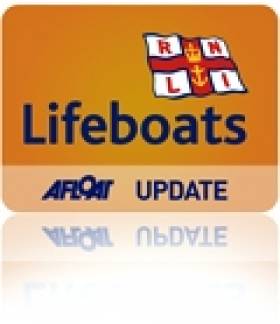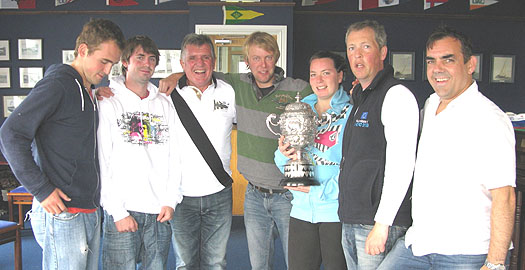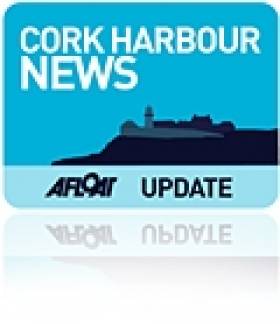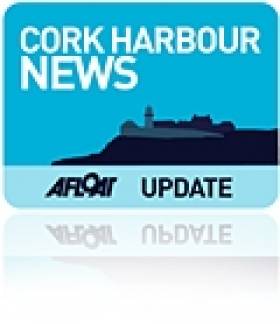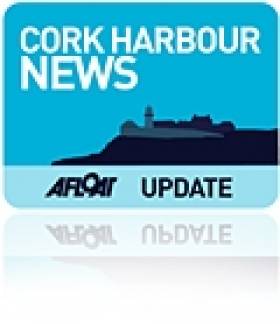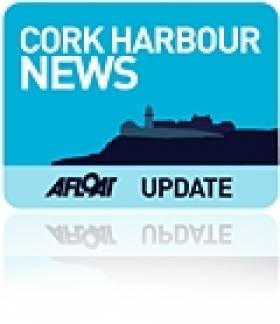Displaying items by tag: Cork Harbour
#rnli – Crosshaven RNLI lifeboat was requested to launch to a 6m Rib (Rigid Rib) that had run aground last evening in Lough Mahon in Cork Harbour.
Crosshaven lifeboat launched shortly after 10pm last evening after receiving reports that the RIB with four people on board was aground North of Hop Island. The lifeboat with volunteers Alan Venner, Con Crowley and Alan Barton on board quickly made their way to the Lough Mahon Area.
The Rib was eventually located on mud banks between the main shipping channel and the Douglas river channel after the casualty fired distress flares and turned on navigation lights. The lifeboat crew had to slowly work their way up the unlit channel until they were within a hundred metres of the casualty.
Crew member, Con Crowley successfully attempted to swim on his back across the mud with a tow line to the casualty vessel where he medically assessed all the casualties. One casualty was cold and wet after initially entering the mud to push the vessel off.
As the tide was turning and beginning to fill, the crew had to wait until enough water was under the casualty boat to haul it off the mud. Two of the casualties were then transferred to the lifeboat and Con Crowley helmed the casualty vessel back to Crosshaven.
The casualty vessel and the lifeboat arrived back at Station at 1.45am, was cleaned down and refuelled and readied for service at 2.30am
#yachtclubs – The antiquity of Irish recreational sailing is beyond dispute, even if arguments arise as to when it started, and whether or not the Royal Cork YC really is the world's oldest club in its descent from the Water Club of the Harbour of Cork from 1720. But all this seems academic when compared with the impression made by relics of Ireland's ancient sailing traditions.
In just six short years, the Royal Cork Yacht Club will be celebrating its Tercentenary. In Ireland, we could use a lot of worthwhile anniversaries these days, and this 300th has to be one of the best. The club is so firmly and happily embedded in its community, its area, its harbour, in Munster, in Ireland and in the world beyond, that it is simply impossible to imagine sailing life without it.
While the Royal Cork is the oldest, it's quite possible it wasn't the first. That was probably something as prosaic as a sort of berth holder's association among the owners of the ornamental pleasure yachts which flourished during the great days of the Dutch civilisation in the 16th and 17th Centuries. They were based in their own purpose-built little harbours along the myriad waterways in or near the flourishing cities of The Netherlands. Any civilisation which could generate delightful bourgeois vanities like Rembrandt's Night Watch, or extravagant lunacies such as the tulip mania, would have had naval-inspired organised sailing for pleasure and simple showing-off as central elements of its waterborne life.
Just sailing for pleasure and relaxation, rather than going unwillingly and arduously afloat in your line of work, seems to have been enough for most. Thus racing – which is the surest way to get some sort of record kept of pioneering activities – was slow to develop, even if inter-yacht matches were held, particularly once the sport had spread to England with the restoration of Charles II in 1660.
Ireland had not the wealth and style of either Holland or England, but it had lots of water, and it was in the very watery Fermanagh region that our first hints of leisure sailing appeared. It's said of Fermanagh that for six months of the year, the lakes are in Fermanagh, and for the other six, Fermanagh is in the lakes. Whatever, the best way to get around the Erne's complex waterways system, which dominates Fermanagh and neighbouring counties, was by boat. By the 16th Century Hugh Maguire, the chief of the Maguires, aka The Maguire, had a Lough Erne-based fleet, some boats of which were definitely for ceremonial and recreational use.
Sport plays such a central - indeed total - role in Irish life that it's highly likely these pleasure sailing boats were sometimes used for racing. However, the first recorded race anywhere in Ireland took place in Dublin Bay in 1663 when the polymath Sir William Petty, having built his pioneering catamaran Simon & Jude, then organised a race with a Dutch sailing vessel and a local "pleasure boatte" of noted high performance. This event, re-sailed in 1981 when the indefatigable Hal Sisk organised the building of a re-creation of the Simon & Jude, resulted both times in victory for the new catamaran. But because a larger sea-going version of the Simon & Jude, called The Experiment at the suggestion of Charles II himself, was later to founder with all hands while on a testing voyage in the Bay of Biscay, the multi-hull notion was abandoned in Europe for at least another two centuries.
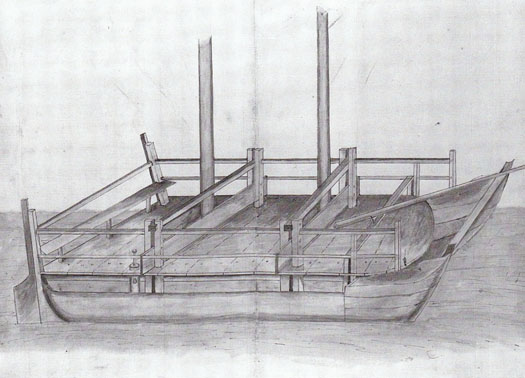
Contemporary drawing of the 17th Century catamaran Simon & Jude, which was built in Dublin and tested in the bay in an early "yacht race" in 1663.
We meanwhile are left wondering just what was this "pleasure boatte" was, and who owned and sailed it. Its existence and good sailing performance seems to have been accepted as unremarkable in Dublin Bay, yet no other record or mention of it has survived.
It was the turbulent life of Munster in the 17th Century which eventually created the conditions in which the first yacht club was finally formed. As the English Civil War spread to Ireland at mid-Century with a mixture of internecine struggle and conquest, the Irish campaigner Murrough O'Brien, the Sixth Baron Inchiquin, changed sides more than once, but made life disagreeable and dangerous for his opponents whatever happened to be the O'Brien side for the day.
Yet when the forces supporting Charles II got back on top in 1660 after the death of Cromwell in 1658, O'Brien was on the winning side. As the dust settled and the blood was washed away, he emerged as the newly-elevated Earl of Inchiquin, his seat at Rostellan Castle on the eastern end of Cork's magnificent natural harbour, and his interests including a taste for yachting acquired with his new VBF Charles II.
But there was much turmoil yet to come with the Williamite wars in Ireland at the end of the 17th Century. Yet somehow as the tide of conflict receded, there seemed to be more pleasure boats about Cork Harbour than anywhere else, and gradually their activities acquired a level of co-ordination. The first Earl of Inchiquin had understandably kept a fairly low profile once he got himself installed in his castle, but his descendants started getting out a bit and savouring the sea. So when the Water Club came into being in 1720, the fourth Earl of Inchiquin was the first Admiral.
In the spirit of the times, having an aristocrat as top man was sound thinking, but this was truly a club with most members described as "commoners", even if there was nothing common about their exceptional wealth and their vast land-holdings in the Cork Harbour area. Much of it was still most easily reached by boat, thus sailing passenger vessels and the new fancy yachts interacted dynamically to improve the performance of both.
Yet there was no racing. Rather, there was highly-organised Admiral Sailing in formation, something which required an advanced level of skill. However, many of the famous club rules still have a resonance today which gives the Water Club a sort of timeless modernity, and bears out the assertion by some historians that, as it all sprang to life so fully formed, the formation date of 1720 must be notional, as all the signs are that there had been a club of some sort for years beforehand.
But either way, it makes no difference to the validity or otherwise of the rival claim, that the Squadron of the Neva at St Petersburg in Russia, instituted by the Czar Peter the Great in 1718 to inculcate an enthusiasm for recreational sailing among Imperial Russia's young aristocrats, was the world's first yacht club. It was no such thing. It was in reality a unit of the Russian navy, and imposed by diktat from the all-powerful ruler. As such, it was entirely lacking the basic elements of a true club, which is a mutual organisation formed by and among equals.
Yet as the Water Club of the Harbour of Cork had no racing with results published in what then passed for the national media, we are reliant on the few existing club records and some travel writing from the time for much of our knowledge of the early days of the Water Club. That, and the Peter Monamy paintings of the Water Club fleet at sea in 1738.
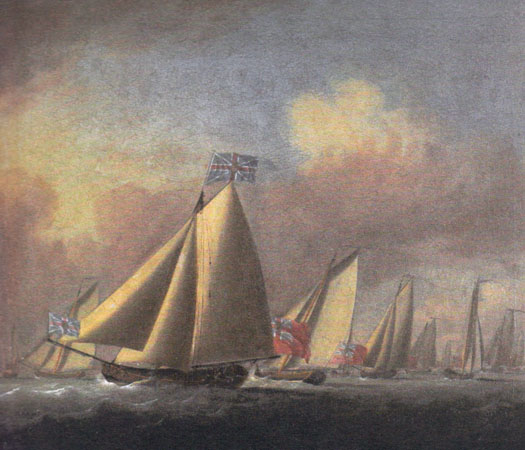
A remarkably well-disciplined fleet. Peter Monamy's 1738 painting of the yachts of the Water Club at sea off Cork Harbour. They weren't racing, but were keeping station in carefully-controlled "Admiral Sailing". Courtesy RCYC
Fortunate indeed are the sailors of Cork, that their predecessors' activities should have been so superbly recorded in these masterpieces of maritime art. The boats may look old-fashioned to a casual observer, yet there's something modern or perhaps timeless in this depiction of the fleet sailing in skilled close formation, and pointing remarkably high for gaff rigged boats as they turn to windward. Only a genuine shared enthusiasm for sailing could have resulted in such fleet precision, and in its turn in a memorable work of art. It is so much part of Irish sailing heritage that we might take it for granted, but it merits detailed study and admiration no matter how many times you've seen it already.
Shortly after Monamy's two paintings were completed, Ireland entered a period of freakish weather between 1739 and 1741 when the sun never shone, yet it seldom if ever rained, and it was exceptionally cold both winter and summer. It is estimated that, proportionately speaking, more people died in this little known famine than in the Great Famine itself 104 years later. While the members of the Water Club would have been personally insulated from the worst of it, the economic recession which struck an intensely agricultural area like Cork affected all levels of society.
Thus the old Water Club saw a reduction in activity, but though it revived by the late 1740s, the sheer energy and personal commitment of its early days was difficult to recapture, and by the 1760s it was becoming a shadow of its former self. Nevertheless there was a revival in 1765 and another artist, Nathanael Grogan, produced a noted painting of Tivoli across from Blackrock in the upper harbour, with a yacht of the Water Club getting under way for a day's recreation afloat, the imminent departure being signalled by the firing of a gun.
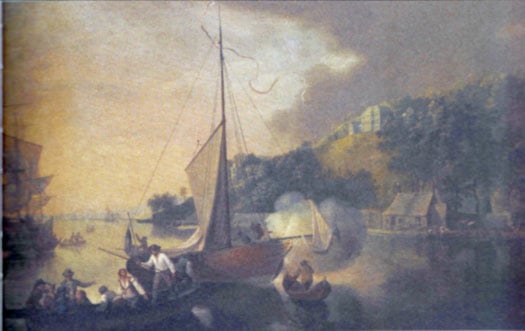
The best way to get the crew on board....on upper Cork Harbour at Tivoli in 1765, a yacht of the reviving Water Club fires a gun to signal imminent departure.
However, it was on Ireland's inland waterways that the next club appeared – Lough Ree Yacht Club came into being in 1770, and is still going strong. That same year, one of the earliest yacht clubs in England appeared at Starcross in Devon, but it was in London that the development pace was being most actively set with racing in the Thames for the Cumberland Fleet. Some members of this group, after the usual arguments and splits which plague any innovative organisation, in due course re-formed themselves as the Royal Thames Yacht Club in the early 1800s. But the famous yet unattributed painting of the Cumberland Fleet racing on the Thames in 1782, while it is slightly reminiscent of Monamy's painting of the Water Club 44 years earlier, undoubtedly shows boats racing. And they'd rules too – note the port tack boat on the right of the picture bearing off to give way to the boat on starboard.
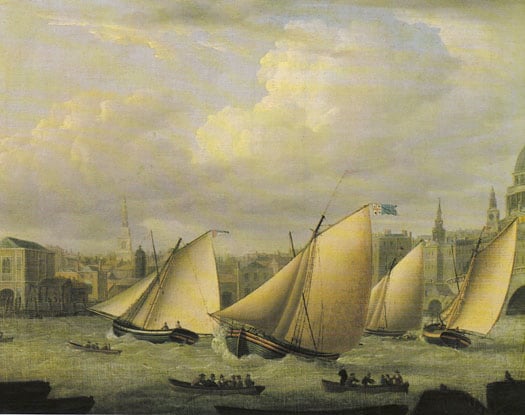
Definitely racing – the Cumberland Fleet, precursor of the Royal Thames Yacht Club, racing in the River Thames at Blackfriars in 1782.
The Thames was wider in those days, but even so they needed strict rules to make racing possible. Dublin Bay offered more immediate access to open water, and there were certainly sailing pleasure boats about. When the Viceroy officially opened the Grand Canal Dock on April 23rd 1796, it was reported that the Viceregal yacht Dorset was accompanied by a fleet of about twenty ceremonial barges and yachts. Tantalisingly, the official painting is almost entirely focused on the Dorset and her tender, while the craft in the background seem to be naval vessels or revenue cutters.
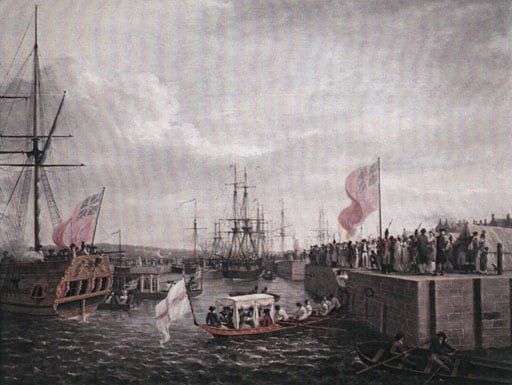
This painting of the opening of the Grand Canal Dock in 1796 tends to concentrate on the ceremonials around the Viceroy's yacht Dorset in the foreground, but fails to show clearly any of the several privately-owned yachts which were reportedly also present....
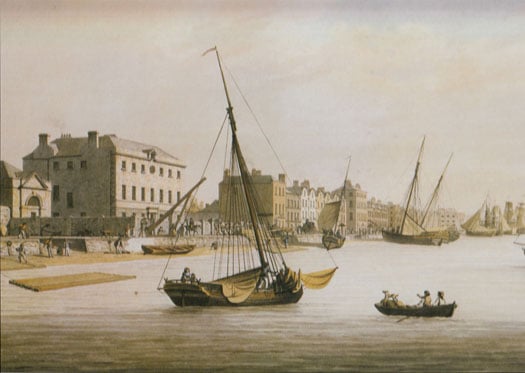
.......but this illustration of the old Marine School on the South Quays in Dublin in 1803 seems to have a yacht – complete with owner and his pet dog on the dinghy in the foreground – anchored at mid-river.
However, a Malton print of the Liffey in 1803 shows clearly what is surely a yacht, the light-hearted atmosphere of waterborne recreation being emphasised by the alert little terrier on the stern of the tender conveying its owner in the foreground Meanwhile in the north of Ireland there was plenty of sailing space in Belfast Lough, while Belfast was a centre of all sorts of innovation and advanced thinking. Henry Joy McCracken, executed for his role in the United Irishmen's rising in 1798, was a keen pioneer yachtsman. As things took a new turn of determined money-making in Belfast after the Act of Union of 1801, some of his former crewmates were among those who formed the Northern Yacht Club in 1824, though it later transferred its activities across the North Channel to the Firth of Clyde, and still exists as the Royal Northern & Clyde YC.
Meanwhile in 1806 the old Water Club of the Harbour of Cork had shown new signs of life, but one result of this was an eventual agreement among members - some of them very old indeed, some representing new blood - that the club would have to be re-structured and possibly even given a new name in order to reflect fresh developments in the sport of yachting. The changeover was a slow business, as it had to honour the club's history while giving the organisation contemporary relevance. Thus it was 1828 before the Royal Cork Yacht Club had emerged in this fully fledged new form, universally acknowledged as the continuation of the Water Club, and incorporating much of its style.
But it was across the north on Lough Erne in 1820 that the world's first yacht club specifically set up to organise racing was formed, and Lough Erne YC continues to prosper today, its alumnae since 1820 including early Olympic sailing medallists and other international champions.
There must have been something in the air in this northwest corner of Ireland in the 1820s, for in 1822 the men who sailed and raced boats on Lough Gill at Sligo had a pleasant surprise. Their womenfolk got together and raised a subscription for a handsome silver trophy to be known as the Ladies' Cup, to be raced for annually – and it still is.
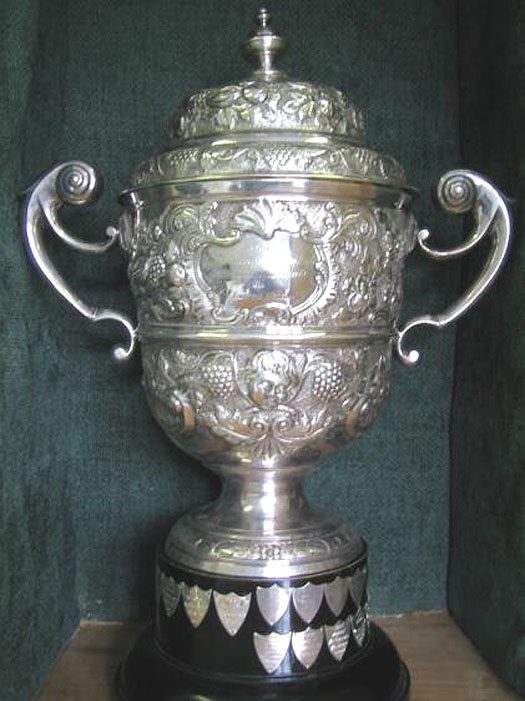
Instituted in 1822, the Ladies' Cup of Sligo YC is the world's oldest continually-contested annual sailing trophy.
Annual challenge cups now seem such a natural and central part of the sailing programme everywhere that it seems extraordinary that a group of enthusiastic wives, sisters, mothers and girlfriend in northwest Ireland were the first to think of it, yet such is the case. Or at least theirs is the one that has survived for 192 years, so its Bicentenary in 2022 is going to be something very special.
Those racing pioneers of the Cumberland Fleet had made do with new trophies freshly presented each year. And apparently the same was the case initially at Lough Erne. But not so very far down the road, at Sligo, somebody had this bright idea which today means that the museum in Sligo houses the world's oldest continually raced-for sailing trophy, and once a year it is taken down the road to the Sligo YC clubhouse at Rosses Point to be awarded to the latest winner – in 2013, it was the ever-enthusiastic Martin Reilly with his Half Tonner Harmony.
The Ladies Cup was won in 2013 by Martin Reilly's Half Tonner Harmony. Pictured with their extremely historic trophy are (left to right) Callum McLoughlin, Mark Armstrong, Martin Reilly, John Chambers, Elaine Farrell, Brian Raftery and Gilbert Henry
However, although the Ladies' Cup may have pioneered a worthwhile trend in yacht racing, it wasn't until 1831 that they thought of inscribing the name of the winner, and that honour goes to Owen Wynne of Hazelwood on the shores of Lough Gill. But by that time the notion of inscribing the winners was general for all trophies, and a noted piece of the collection in the Royal Cork is the Cork Harbour Regatta Cup 1829, and on it is inscribed the once-only winner, Caulfield Beamish's cutter Little Paddy.
The name of noted owner, skipper and amateur yacht designer Caulfield Beamish came up here some time back, when we were discussing how in 1831 he took a larger new yacht to his own design, the Paddy from Cork, to Belfast Lough where he won a stormy regatta. So you begin to understand the mysterious enthusiasm people have for sacred relics when you see this cup with its inscription, and realise that it's beyond all doubt that this now-forgotten yet brilliant pioneer of Cork Harbour sailing development personally held this piece of silverware.
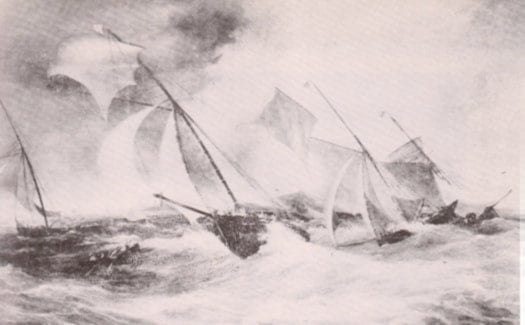
Caulfield Beamish's new cutter Paddy from Cork (which he designed himself) winning a stormy regatta in Belfast Lough in 1831
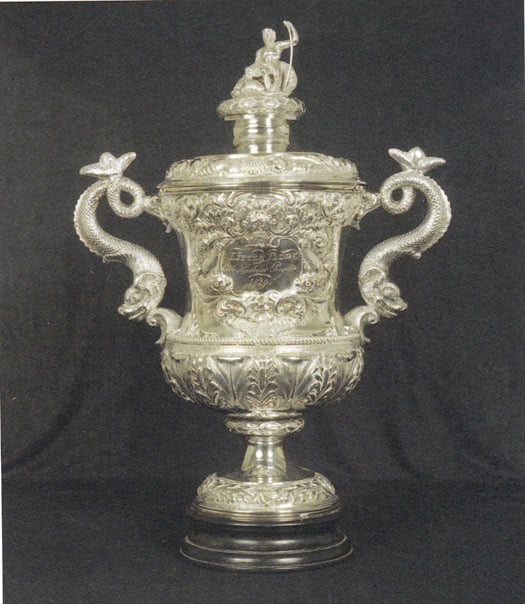
The Cork Harbour Regatta Cup of 1829.....Courtesy RCYC
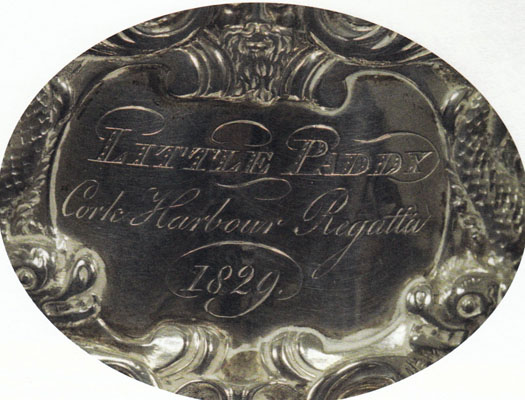
....and on it is inscribed the winner, Caulfield Beamish's earlier boat, Little Paddy, which he also designed himself. Courtesy RCYC
Another pioneer in yacht racing at the time was the Knight of Glin from the Shannon Estuary, who in 1834 was winning all about him with his cutter Rienvelle, his season's haul including a silver plate from a regatta in Galway Bay – it's now in Glin Castle – while he also seems to have relieved fellow Limerick owner William Piercy of £50 for a match race in Cork Harbour against the latter's cutter Paul Pry.
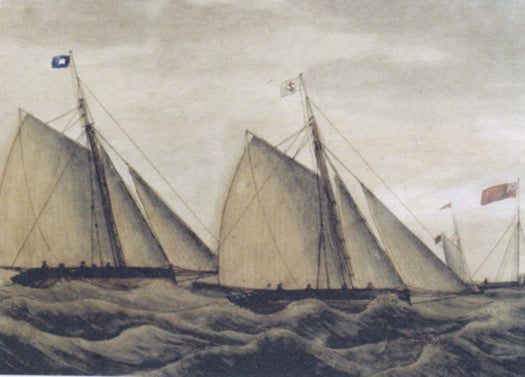
The lads from Limerick hit Cork. William Piercy's Paul Pry racing for a wager of £50 against the Knight of Glin's Rienvelle in Cork Harbour in 1834. When Paul Pry won Cork Harbour Regatta a few weeks later, the band on the Cobh waterfront played Garryowen. Courtesy RCYC
But of all the fabulous trophies in the Royal Cork collection, the one which surely engenders the most affection is the Kinsale Kettle. It goes back "only" to 1859, when it was originally the trophy put up for Kinsale Harbour Regatta. But this extraordinarily ornate piece of silverware was not only the trophy for an annual race, it was also the record of each race, as it's inscribed with brief accounts of the outcomes of those distant contests.
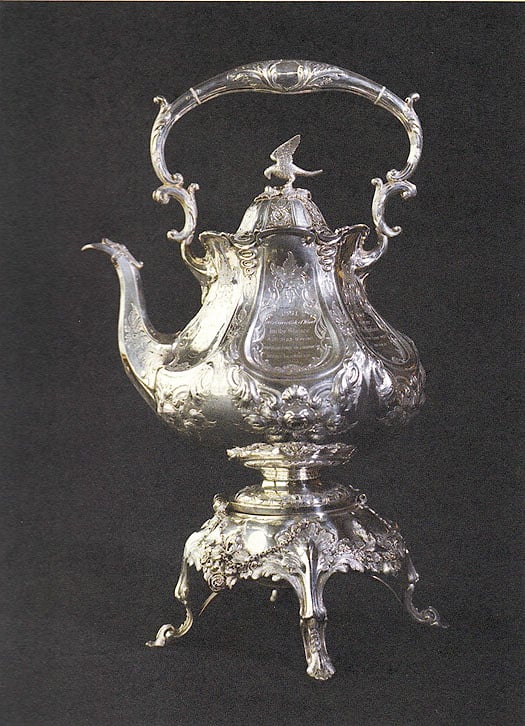
An extraordinary piece of Victorian silverware. The "Kinsale Kettle" from 1859 is now the Royal Cork YC's premier trophy.
Today, it continues to thrive as the Royal Cork Cup, the premier award for Cork Week. The most recent winner in 2012 was Piet Vroon with his superb and always enthusiastic Tonnere de Breskens. The fact that this splendid ambassador for Dutch sailing should be playing such a central role in current events afloat here in Ireland brings the story of our sport's artworks and historical artefacts to a very satisfactory and complete circle.
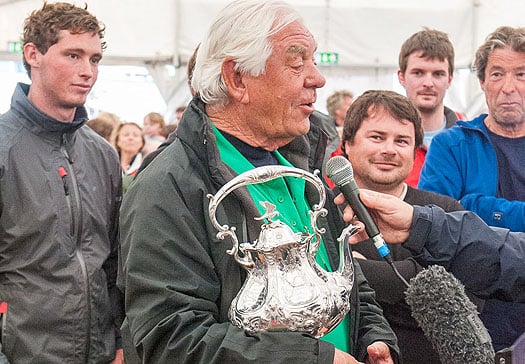
More tea, skipper? The current holder of the Kinsale Kettle, aka the Royal Cork Cup, is Piet Vroon of Tonnere de Breskens. Photo: Bob Bateman
Cork Boat Club Signs MOU with Cork's Emergency Services
#corkharbour – Recognising the need for adequate and safe launching facilities in the upper river area for agencies responding to emergencies and river searches, a jointly funded project by Port of Cork and Cork City Council ensuring Cork Boat Club's eastern slipway is operational and fit for purpose, has been completed. As a result of this project and to ensure continual sharing of the facilities, a memorandum of understanding (MOU) between Cork Boat Club, Port of Cork, Cork City Fire Brigade and Cork City Civil Defence was signed today.
Cork Boat Club has for many years allowed the Emergency Services access to its grounds and slipway. Sharing of access to the sole operational slip at times however, caused congestion between Cork Boat Club's day-to-day launch, recovery operations and the needs of the local Emergency Service. Cork Boat Club agreed to provide 24/7 access to the Emergency Services and Port of Cork, and any other agencies under their control, when responding to an emergency situation or conducting training, while Port of Cork and Cork City Council agreed to jointly fund the repair of Cork Boat Club's second slipway to ease launching congestion at peak times.
According to the Port of Cork Harbour Master, Captain Paul O'Regan, this MOU is a positive step for all parties involved.
He said: "We were very pleased to be a part of the project, which demonstrates the close working relationship between the City Council and the Port Company. The MOU agreed between the parties will provide a valuable resource for all involved. Cork Boat Club already facilitates boat storage for Blackrock Coastal Rowing Club and this agreement is a further example of their community focus"
Captain O 'Regan continued: "This arrangement will operate on a goodwill basis for the benefit of the community at large and will greatly assist the emergency services, which are very often faced with challenging search and recovery tasks."
Cork Boat Club Chairman John McCarthy added: "This arrangement is in line with our deeply held community based ethos and is a win-win for all parties. Cork Boat Club has had tremendous success both on and off the water in recent years, and this is another significant step in the right direction."
On behalf of Cork City Fire Brigade, the MOU was welcomed by Chief Fire Officer, Mr John Ryan.
All parties in this Memorandum of Understanding will meet formally on an annual basis to review its operation and to ensure that any associated issues are managed.
Cork Boat Club in Blackrock Village was established in 1899 and has 200 members. In 2013 it had the distinction of having fourteen of its rowers selected to represent Ireland at International level, the highest level of international representation of any club in the country.
#corkharbour – Camden Fort Meagher, an historic fort in Cork Harbour will headquarter June's International Sailing event for women hosted by Royal Cork Yacht Club it was announced yesterday. An Irish team for the event has yet to be anounced due to late changes in the selection process.
Sixteen international teams are expected to travel and compete and will include some of the world's highest ranking sailors and potential Olympians. Entries to date have been received from New Zealand, United States, Denmark, France and the Netherlands. As Afloat reported earlier the event will also be the first stage of the Women's International match Racing Association tour.
Sponsored by Cork County Council and the Port of Cork, the World Match Racing Championship for Women is one of the world's highest calibre sporting events.
Cork Harbour renowned for its sailing throughout the world, is hosting this event directly under Camden Fort Meagher, which offers unrivalled viewing to competitors, their families, friends, supporters and general public.
Camden Fort Meagher will be the Event Head Quarters for this international sailing event. This will be a first for the fort. Paul Brierley, project coordinator for Camden Fort Meagher said "we are delighted to be part of this world event, which will allow competitors and spectators to enjoy the wonderful ambience of this historic fort and an ariel view of the racing from its spectacular deck". Royal Cork Yacht Club Admiral, Pat Lyons, explains that "Cork and the Royal Cork Yacht Club were chosen over other locations, such as Long Beach California". "This speaks volumes" he said, "of the commitment and expertise we have in the yacht club and in Crosshaven to be chosen to host such a prominent event here in Cork Harbour".
However not all the sailing will take place in the harbour from the 3rd to 8th of June. On 6th of June the River Lee will play host to a one day event, which will bring the international sailing competition into the heart of Cork City for everyone to enjoy.
Cork County Council and the Port of Cork have come together as Joint Title Sponsors to support this prestigious international sailing even. In recent times both Cork County Council and Port of Cork have invested heavily in the harbour area; promoting sailing and other water based activities to aid development of the harbour. Cork's natural harbour is not only a place to do business, but an attractive tourist destination which offers so much to visitors.
Event Chairman, Ronan Enright, comments "We are delighted with the support that has been shown by our sponsors Cork County Council and the Port of Cork. This sponsorship is not only promoting women's sailing, it is also providing a once in a life time experience within the unique setting of Camden Fort Meagher to both competitors and spectators"
Royal Cork's Dinghy PY 500 Regatta Success in Cork Harbour
#rcyc – Weather obliged beautifully for PY 500 making a perfect Sunday morning event at Royal Cork Yacht Club writes Claire Bateman. And what a magnificent spectacle the PY500 (Portsmouth Yardstick) race turned out to be. The sun was shining and there was a Westerly breeze of some 15 knots lightening slowly during the race. The course was Windward/Leeward around laid marks and consisting of seven rounds.
The event consisted of a mixed dinghy race for vessels holding a PY Handicap of 700-1320. Results are downloadable below as a jpeg file.
Due to the thirty one boats participating and the different speeds involved there were officials in position at each mark to record each competitor rounding for each of the seven rounds. Due to the location of the course up and down the river outside the club magnificent spectator viewing was provided for the large numbers present.
There were many boats from different classes represented and they certainly provided spectacular viewing.
The representatives were from National 18s, 505's, RS 400, RS 200, a lone Finn, Fevas, Fireflies, Lasers of all rig types, a Rankin and the star of the show, a 29er that charged around the course showing such style with a fluorescent orange Gennaker. Spotted sailing his RS 200 with his wife Heather was Sean Craig from the RstGYC. Also sailing from the RCYC's own club boats were 2 Topaz, one Magno and one Omega.
In between all this flying action there were Optimsts, 420s and 1720s all setting out for training and all in all there was a tremendous buzz in the club.
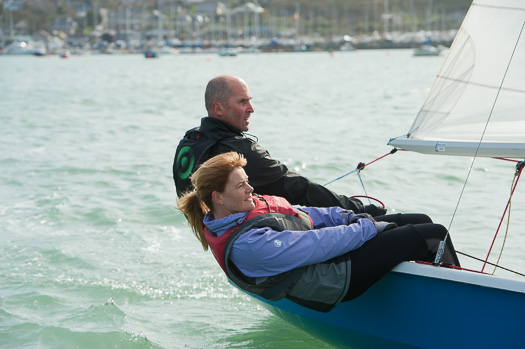
Sean and Heather Craig travelled from Dun Laoghaire for Royal Cork's PY 500. More photos by Bob Bateman below.
It must have made interesting and delightful viewing in the lovely conditions for the members and friends arriving for Sunday lunch at the Club's Globe Restaurant.
All credit due to the organisers and so obviously successful and enjoyable they might consider a repeat performance.
Decision Due Next Month On Future Of Cork Harbour Toxic Dump
#CorkHarbour - 24 April is the date set for a decision on the clean-up of the toxic waste site on Haulbowline Island in Cork Harbour, as RTÉ News reports.
The news comes at the conclusion of the oral hearing into proposals for the former Irish Steel/Ispat plant, for which the only submission received was from the applicant Cork City Council.
The hearing was told by risk consultants representing the council that the site in its present state no immediate or long-term risk to the community at large.
However, Dr Cecilia MacLeod of consultants WYG echoed the concerns of local councillors last month over breaches in the embankments around the toxic dump, which contains some half a million tonnes of waste, when she said the site remains a health risk to the locality.
Plans for the site currently involve landscaping the area, with a perimeter wall to prevent leaching of potentially hazardous or carcinogenic matter.
RTÉ News has more on the story HERE.
Cobh Railway Station Building Undergoes a Renovation
#corkharbour – The building at Cobh Railway Station is currently undergoing renovation with the intention of opening the premises as a dual operation, offering tourism information on Cork City and County to visitors, in particularly cruise passengers, and as a vibrant exhibition space. A new company 'Cobh Maritime Development Company Ltd' has formed to manage and develop this building and consists of directors from the Port of Cork, Cobh Heritage Centre, Cobh Tourism, SECAD, Cobh & Harbour Chamber, Cobh Town Council and Cork City Council. Their main aim is to develop and promote the potential of Cobh, East Cork, Cork City and Cork Harbour as an area of significant tourism, maritime, historical and economic importance.
South and East Cork Area Development Ltd. (SECAD) is grant aiding the renovation of the building through the Rural Development Programme 2007-2013 supported through the European Agricultural Fund for Rural Development and the National Development Plan. The project will cost in the region of €150,000 and it is anticipated to have the building open for the commencement of the cruise season in April 2014.
The building currently being converted is a protected structure owned by CIE Properties, which forms part of the Cobh Railway Station Facility and which underwent a major upgrade in recent years. CIE Properties have enthusiastically welcomed the approach to utilise the available space and a long term lease agreement between Cobh Maritime Development Company Ltd and CIE Properties has been agreed. The facility will be managed by Cobh Maritime Development Company Ltd as a not-for-profit facility which will serve to promote and complement existing tourism, economic and community activity in the Cork Harbour Area. It is envisaged the building will open throughout the year and will capitalise on the increased footfall from cruise passengers from April to November each year. The building will also be used to accommodate cruise passengers who are either embarking or disembarking from a cruise ship. Cobh Maritime Development Company Ltd, together with SECAD, hopes to employ two or three staff through the Tus community employment scheme.
Announcing the details of the project, Cobh Maritime Development Company Ltd Chairman, Captain Michael McCarthy said: "This is a very exciting project for the Cobh and Cork region which will see a disused building turned into a tourism information hub and a space for exhibitions. The railway station already has a high footfall during the summer months when cruise liners are in Cobh and this building will offer passengers a place to absorb what the region has to offer either before or after a trip by train to Cork City."
He continued: "Our aim is to complement other venues in Cobh offering similar exhibition space and Cobh Maritime Development Company Ltd will work closely with all local tourism venues to maximise the regions offering. We are also working closely with Cork City and Cork County Council to ensure Cork City and County attractions and events are also promoted to visitors."
Following a tender application, local Cork Company MMD Construction was awarded the contract to carry out the necessary works to the building, which commenced in December 2013.
Councillors Fear Toxic Dump Leak In Cork Harbour
#CorkHarbour - Cork County Council is investigating reports that defences built around the toxic dump on Haulhbowline Island have been breached in the recent severe weather.
According to the Irish Examiner, two Cobh-based councillors reported seeing breaches in the embankments around the dump, which contains an estimated half a million tonnes of waste - including toxic heavy metals and various cancer causing materials such as Chromium 6.
It's now feared that the recent high tides have carried toxic waste out of the site and contaminated the waters of Cork Harbour.
The council has confirmed that tests are being carried out at and around the site, next to the former Irish Steel/Ispat plant.
A full clean-up operation of the toxic dump is expected to begin later this year, though the contract for the job has not yet been awarded, pending the decision of the Environmental Protection Agency on a waste licence application and a nod from An Bord Pleanála for redevelopment of the site.
ISAF Match Racing Returns to Royal Cork Yacht Club
The ISAF Women's Match Racing Worlds Circuit arrives in Cork Harbour from June 3rd to 8th, 2014 and will be hosted by Royal Cork Yacht Club writes Claire Bateman.
What a prospect both exciting and daunting lies ahead for Royal Cork Yacht Club, organisers of the prestigious Women's Match Racing Worlds June 3rd to 8th, 2014. Not that the club is any stranger to such events having hosted the ISAF Nations Cup Grand Final in September 2006 with huge success and also the European leg of the ISAF Match racing circuit in the nineties. The event is part of the tour for the Women's International match Racing Association (www.wimra.org)
Match Racing is one of the more intensely exciting forms of racing and the pace never slows. Race Officers tasked with the running of racing for the sixteen teams in this event are Peter Crowley (IRO) assisted by Alan Crosbie (IRO) who incidentally also officiated at the 2006 Nations Cup Grand Final. The event is being run in the Sailfleet J80's. It will certainly be nice to see these boats back in Cork.
Numerous detailed site inspections and high level consultations took place before Cork was chosen ahead of all other venues such as such as Long Beach California to host the competition. Both Cork County Council and the Port of Cork have agreed to be joint title sponsors of the world rated event.
The planned sailing in the waters of Cork Harbour, close to shore and under Camden Fort Meagher, offers unrivalled viewing to the competitors' families, friends, supporters and general public, who can also avail of the magnificent facilities at the refurbished historic fort to enjoy close up viewing of the competition.
The ISAF Women's Match Racing Worlds is an annual event that was first held in Genoa in 1999. Sailors are invited to attend based on their world ranking. Invitations will be issued by ISAF and the organising authority in February based on world rankings at that time. The 2013 Match Racing Worlds took place in Busan, Korea where 2012 Spanish Olympic Gold Medalist Tamara Echegoyen took the 2013 world match racing title.
Of course the event will also have a lighter side and an excellent entertainment plane is in place. On Friday, June 6th, a unique event is planned for the city. It is planned to hold a "Sailing in the City" day on the river in front of Kennedy Quay. An event will be held on the city quays followed by an early evening entertainment programme. This will provide the people of Cork with a wonderful opportunity to see and meet Olympic standard sailors close up and bring unparalleled top notch racing into the heart of the city. There is a match race planned for the sailors (watch out for fun on the river) and also an exhibition race where local schoolchildren could have the opportunity of sailing with these unrivalled top quality sportswomen.
The Women's Match Racing Worlds is a world sailing event of the highest calibre and is an opportunity for everybody to come to Crosshaven and enjoy the carnival atmosphere of the village for the event and experience a feast of intense sailing viewing from the world ranking surrounds of the magnificent Camden Fort Meagher.
Safehaven's Pilot Boat 'Interceptor 48' Tested in Storm Force Conditions
#storm – December storms provided Cork harbour boatbuilder Safehaven Marine with the perfect test bed for sea keeping trials with winds of Force 12 and near 30ft waves off the coast of Cork Harbour. On test was Safehaven's Interceptor 48, a self-righting pilot/ Search and Rescue vessel.
Almost the ultimate conditions prevailed for the test, storm force winds of a sustained duration and fetch creating mountainous seas nearly 30ft high, a strong ebb tide running out against the waves creating a maelstrom of steep breaking waves over the harbour rock at the entrance to Cork Harbour, all combined with perfect visibility.
Safehaven Managing director Frank Kowalski told Afloat, 'I think this video portrays the immense power and danger of the sea'. It certainly does and it also shows the seakeeping abilities of Safehaven's Interceptor pilot and rescue designs.


























